“I started drinking probiotic tonics every morning, and in just one week, I felt less bloated, more regular, and way more energized.”
This guide covers the top 10 probiotic drinks, including Yakult, kefir, kombucha, and more, with clear pros, cons, and how each one can help support gut health, digestion, and mood.
Whether you’re battling bloating or simply want a daily boost for your microbiome, this updated 2025 list breaks down the best choices, from store-bought favorites to DIY blends.
What Are Probiotic Drinks and Why They Matter for Gut Health?
Let’s be honest, the term “probiotic drink” sounds like something you’d find in a supplement aisle next to overpriced powders and promises. But what it actually refers to is far more grounded: it’s a drink that contains live, beneficial microorganisms, mostly bacteria, meant to help your gut do its job better. To complement these drinks, our Baked Cottage Cheese Eggs offer a protein-packed breakfast option that supports digestive health.
Think of it like this: your digestive system is a bustling city of microbes. Probiotic drinks send in reinforcements, new “citizens” that can help keep things running smoothly when the native population’s out of whack. Maybe it’s been a week of too much takeout. Maybe you’re stressed, sleep-deprived, or just feeling… off. That’s when probiotics can step in.
How These Little Organisms Ended Up in Your Glass
Most of the time, these drinks are born through fermentation, a natural, age-old process where sugars get consumed by bacteria or yeast. That transformation creates not just flavor but a microscopic ecosystem of helpful bugs. Kombucha, kefir, yogurt drinks like Yakult, they all ride this same microbial wave. For a refreshing fermented option, try our Kung Pao Chicken Panda Express recipe, which pairs well with probiotic beverages.
But there’s a catch: not every fermented drink at the store is “probiotic.” Some are pasteurized, meaning all the good stuff is killed off before you take a sip. Look for labels that say “live and active cultures”, anything less, and you’re just drinking glorified juice. To ensure you’re getting the most from your meals, our Banana Bread Recipe Without Baking Soda is a great homemade option that retains beneficial nutrients.
Popular Types of Probiotic Drinks (and Why They’re Not All the Same)
- Kombucha: Fizzy, tart, and a bit polarizing, fermented tea that’s low in sugar and often spiked with herbs or fruit. For a homemade twist, explore our Anti-Inflammatory Lemon-Blueberry Smoothie, which offers similar benefits in a different form
- Milk or Water Kefir: Creamy or light, depending on the base. Kefir’s like yogurt’s wilder cousin, more strains, more tang. Pair it with our Baked Cottage Cheese Eggs for a protein-rich, gut-friendly breakfast.
- Yakult & Activia: Familiar, dairy-based, and backed by clinical studies (especially Yakult’s L. casei Shirota strain). For a dairy-free alternative, our Refreshing Cucumber Tomato Salad Recipe is a light, probiotic-friendly option.
- Fermented Tonics: Gut shots made from ginger, beets, carrots, intense but effective. Complement these with our Marry Me Chicken Pasta Recipe for a balanced meal that supports gut health.
Each one hits differently. Some are daily drivers. Others? More like gut resets. To find the right balance, consider starting with our Anti-Inflammatory Lemon-Blueberry Smoothie, which is both gentle and effective.
FAQ — Can’t I Just Take a Probiotic Pill Instead?
Q: Are drinks better than probiotic supplements?
A: It depends. Pills might give you a higher CFU count (colony-forming units), but drinks come with added benefits: enzymes, hydration, natural fiber, and, let’s be real, they’re often more enjoyable. It’s not either-or. Some folks do both. But if you’re easing into gut health, sipping your way in might just be smarter.
Why People Are Turning to Probiotic Drinks
It didn’t happen overnight, but something’s shifted. We’ve gone from ignoring our guts entirely, powering through bloat, fatigue, indigestion like it was normal, to suddenly realizing: wait, maybe my gut is trying to tell me something.
That’s where probiotic drinks come in. For a lot of people, they’re not just a trendy add-on, they’re the first step toward fixing something they didn’t know was off.
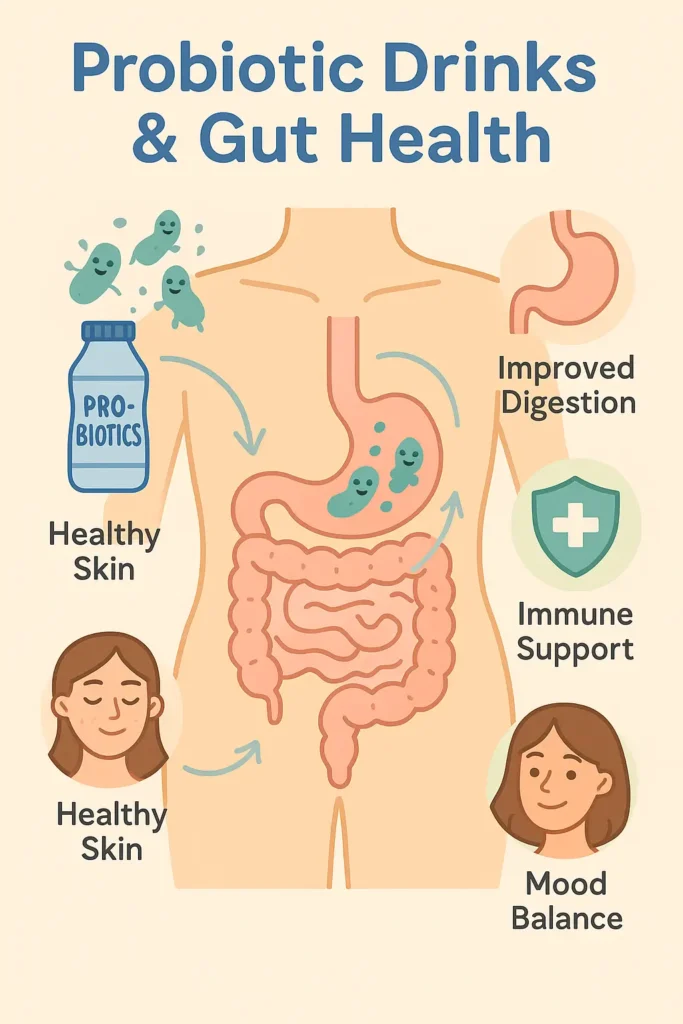
Digestive Discomfort Is Now the Default
Let’s call it what it is, bloating, gas, irregularity… it’s become so common we’ve normalized it. And yet, so much of it points back to gut imbalance. Whether from antibiotics, stress, processed food, or even lack of sleep, our internal ecosystem takes hits daily.
Probiotic drinks offer a low-effort, low-commitment way to start nudging things back into balance. No pills. No major diet overhaul. Just something you can sip, and actually feel working (well, sometimes).
The “Gut-Body” Connection Is Finally Mainstream
What used to be fringe science, that your gut could affect your brain, immune system, even skin, is now front-page stuff. Studies are confirming what traditional cultures have known for centuries: your gut is the command center.
And for many, adding a probiotic drink is their way of tapping into that. It feels empowering. Like a small, smart choice in a world where everything feels overwhelming.
FAQ — Will I Feel Different After Drinking Probiotics?
Q: Can probiotic drinks actually make me feel better?
A: You might. Some people report less bloating in a few days. For others, it’s subtler, more regularity, clearer skin, better energy. And sure, for a few, there’s no noticeable change at all. Bodies are weird like that. But for many, especially when paired with small diet tweaks, it’s enough of a shift to keep going.
Top 7 Best Probiotic Drinks for Gut Health and Wellness
There’s no one-size-fits-all when it comes to probiotic drinks. Some go for flavor. Others prioritize potency. And depending on your gut, one person’s miracle tonic might be another’s “meh.” But if you’re wondering where to start, these are the probiotic MVPs worth exploring, each with its own vibe, benefit, and cult following.
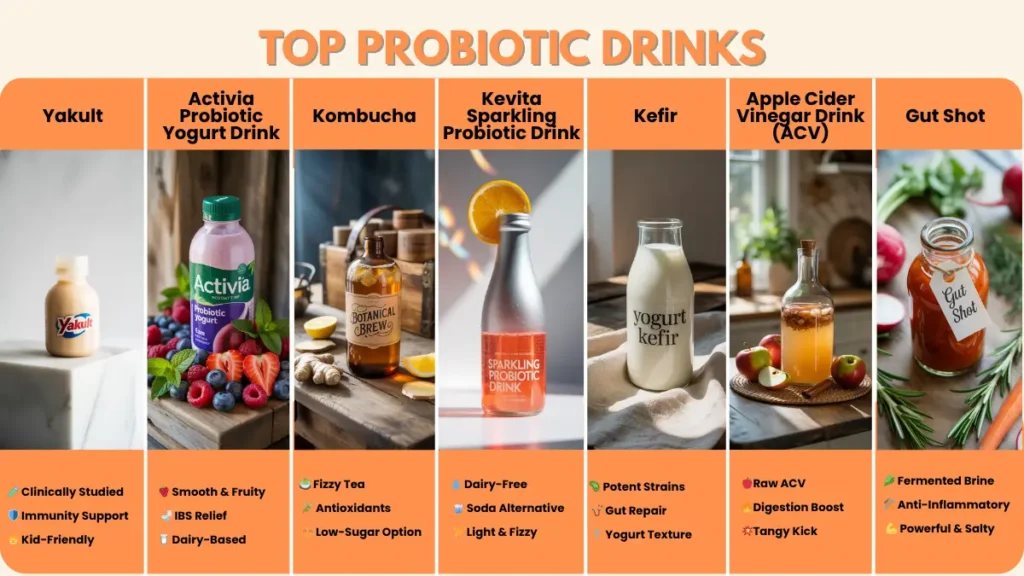
Yakult
- Why it works: Clinically studied Lactobacillus casei Shirota strain, sweet taste, easy daily habit.
- Taste: Sweet, creamy, kid-friendly.
- Good for: Beginners, immunity support, digestive regularity.
- Heads-up: High in sugar, one of the more processed options, but also the most widely tested.
Activia Probiotic Yogurt Drink
- Why it works: Uses Bifidobacterium animalis (ActiRegularis®), known to aid transit time in the gut.
- Taste: Smooth, fruity, classic yogurt base.
- Good for: Constipation relief, IBS-type symptoms, dairy lovers.
- Heads-up: Dairy-based, not ideal if lactose is your issue.
Kombucha (e.g., Health-Ade, GT’s, Brew Dr.)
- Why it works: Naturally fermented tea with a mix of wild strains + organic acids.
- Taste: Tangy, fizzy, vinegary, acquired, but refreshing.
- Good for: Daily gut maintenance, immune health, sugar swaps (if low sugar).
- Heads-up: Not all kombucha is created equal, some are sugar bombs or pasteurized.
Kevita Sparkling Probiotic Drink
- Why it works: Non-dairy, effervescent, light, made with water kefir grains.
- Taste: Sparkling, flavored, soda-replacement vibe.
- Good for: Low-sugar drinkers, plant-based diets, fizzy cravings.
- Heads-up: Not as potent as dairy kefir or kombucha in CFUs.
Kefir (Lifeway Kefir, homemade)
- Why it works: One of the most diverse strain counts, often over 10 types of live cultures.
- Taste: Tart, thick, drinkable yogurt.
- Good for: Deep gut support, rebuilding flora after antibiotics.
- Heads-up: Strong flavor, may take adjusting, also dairy-heavy unless made with coconut or water.
Apple Cider Vinegar Drinks (e.g., Bragg ACV)
- Why it works: Contains acetic acid and residual cultures (“the mother”), supports digestion.
- Taste: Sharp, tangy, energizing.
- Good for: Bloating, sugar crashes, blood sugar control.
- Heads-up: Not technically a probiotic unless raw/unfiltered, best used alongside other ferments.
Gut Shots (Farmhouse Culture, DIY versions)
- Why it works: Concentrated fermented vegetable brine, pure, potent probiotics.
- Taste: Intense, salty, sour, raw.
- Good for: Serious gut rehab, anti-inflammatory support, DIY enthusiasts.
- Heads-up: Not for the faint-hearted, but highly functional.
FAQ — Is One Probiotic Drink Better Than the Others?
Q: What’s the best probiotic drink overall?
A: Honestly? It depends on your goals. Kefir takes the lead when it comes to diversity and potency. If taste and consistency matter most, Yakult or Activia are great picks. Watching your sugar intake? Kombucha or Kevita could be a better fit. The key is finding a drink that matches your strain needs, and your lifestyle.
Natural & Homemade Probiotic Drinks for Digestive Health
Let’s say store-bought drinks don’t vibe with you. Maybe it’s the sugar content, the price, or just the fact that you have no clue what half the ingredients are. That’s where homemade probiotic drinks come in, natural, cost-effective, and surprisingly easy to make with stuff you already have. For example, this banana bread recipe without baking soda makes a great fiber-rich snack to pair with your gut-friendly drinks, no weird ingredients or additives in sight.
Making your own isn’t just about saving money (though, yeah, you’ll save a ton). It’s about control, over ingredients, potency, and flavors. If you enjoy DIY kitchen wins, you might also love trying this baked cottage cheese eggs recipe, protein-rich, probiotic-friendly, and easy to prep ahead.
3 Simple DIY Probiotic Drinks to Try
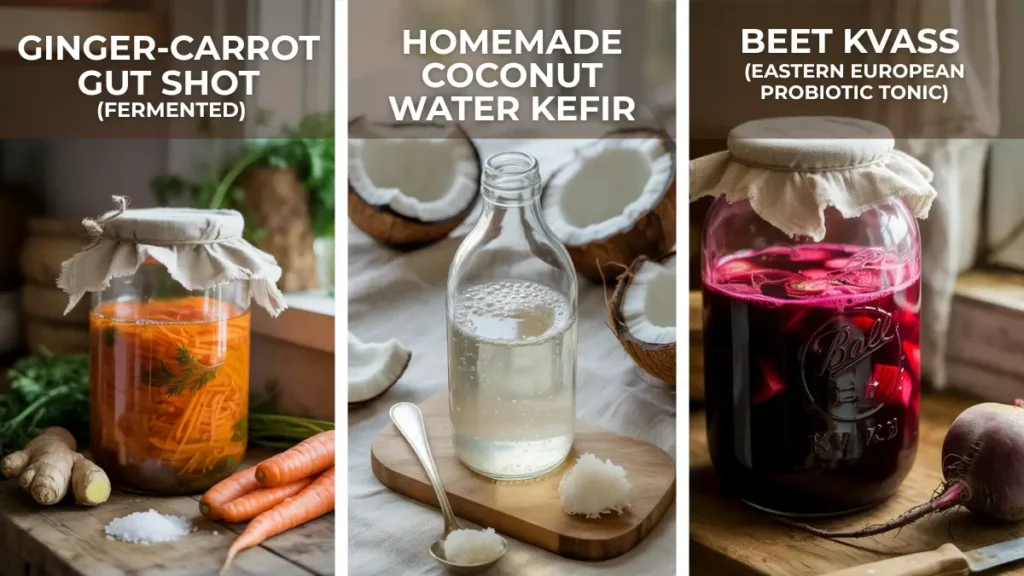
Ginger-Carrot Gut Shot (Fermented)
- How to make it: Grate 4 carrots and a thumb of ginger. Add 2 tsp salt, pack into a jar, and cover with filtered water. Let it sit on your counter (loosely covered) for 2–3 days.
- Why it works: Carrots = prebiotic fiber. Ginger = anti-inflammatory. Fermentation = natural probiotics.
Homemade Coconut Water Kefir
- How to make it: Use kefir grains (available online or from a starter) in coconut water. Ferment 24–48 hours.
- Why it works: Dairy-free, rich in electrolytes, and hosts multiple strains.
Beet Kvass (Eastern European Probiotic Tonic)
- How to make it: Chop raw beets, cover with salty water, ferment in a jar for 3–5 days. Strain and sip like a shot. Want more nutrient-packed veggie ideas? Try this refreshing cucumber tomato salad, hydrating, mineral-rich, and perfect for summer gut health.
- Why it works: Deep liver detox, blood-building, and supports sluggish digestion.
For more fermented drink ideas, explore our Natural Mounjaro Recipe for Weight Loss, which blends leafy greens, citrus, and ginger for a metabolism-boosting beverage.
Tips for Successful Fermentation at Home
- Use non-chlorinated, filtered water, chlorine kills live cultures.
- Keep the jars at room temp, away from direct sunlight.
- Burp sealed jars to release gas if using tight lids.
- Taste-test daily after day 2 to catch your ideal flavor stage.
- Don’t freak out if it bubbles, tthat’s the magic working. And if you’re looking for more kitchen science meets simplicity, check out this recipe for garlic butter chicken bites, easy, satisfying, and better with a fermented veggie side..
FAQ — Are Homemade Probiotic Drinks as Effective as Store-Bought?
Q: Do DIY probiotic drinks work as well as branded ones?
A: In many cases, yes — sometimes even better. Homemade drinks can contain a broader spectrum of microbes, especially if you’re using live starter cultures. The key is freshness: when made right, they’re alive, potent, and entirely free from additives or pasteurization.
How to Choose the Best Probiotic Drink for Your Gut Needs
With so many bottles claiming to “support digestion” or “boost immunity,” it’s easy to get stuck in choice paralysis. But choosing the right probiotic drink doesn’t have to be guesswork, especially if you know what you’re solving for.
Let’s break it down by your body, your goals, and what you can actually stick with.
What’s Your Gut Telling You?
Start with symptoms, not labels. Are you bloated constantly? Struggling with constipation? Reacting to dairy or sugar? The right probiotic drink depends on what’s not working in your digestive system.
- Bloating or irregularity? Try kefir or Activia (rich in fiber-digesting strains).
- Lactose sensitivity? Look at kombucha, water kefir, or coconut yogurt drinks.
- Low energy or immune dips? Yakult’s immune-supported strains (L. casei) or fermented tonics might help.
Check the Label, The Right Way
Don’t just look for the word “probiotic.” Real-deal drinks will have:
- Named strains (e.g., Lactobacillus acidophilus, not just “live cultures”)
- CFU count (ideally in the billions, at time of consumption)
- No pasteurization after fermentation
- Low sugar (ideally <7g per serving, high sugar can offset gut benefits)
- Minimal additives or artificial flavors
Lifestyle Considerations
- Busy? Shelf-stable shots like Gut Shots or Yakult are grab-and-go options.
- Vegan? Kevita, water kefir, kombucha, and some coconut kefirs are dairy-free.
- On a budget? DIY drinks (like carrot ginger ferments or beet kvass) cost pennies per serving.
- Skeptical? Start with a familiar base like yogurt drinks, your taste buds won’t rebel.
For a refreshing, anti-inflammatory option, try our Anti-Inflammatory Lemon-Blueberry Smoothie, which combines blueberries, lemon, and kale for a gut-friendly boost.
FAQ — How Do I Know If a Probiotic Drink Is “Working”?
Q: What should I feel after drinking probiotics regularly?
A: Subtle changes, not fireworks. Within a week or two, you might notice smoother digestion, less bloating, improved regularity, or even better skin clarity. The effects are often cumulative, not instant. And if nothing shifts after a few weeks, you may need to try a different strain (or address diet/sleep stressors too).
When and How to Drink Probiotic Drinks for Best Results
You’ve got the bottle. You’re ready to commit. But then that tiny internal voice whispers: “Am I even doing this right?” Yeah, we’ve all been there.
The truth? There’s no one perfect formula, just a handful of smart tweaks that can help those friendly microbes actually survive the journey and do their job.
So… When Should You Drink It?
Honestly? It depends.
- First thing in the morning is a classic move. Your gut’s relatively calm, and some studies suggest less acidic stomach conditions give probiotics a better shot.
- But then again, drinking with food has its perks too, especially if your probiotic strain thrives in the buffered environment of a full stomach.
- Nighttime? It’s less studied, but some folks swear by it, especially if digestion tends to flare up in the evening.
You’ll hear conflicting advice because bodies are weird. Best bet? Try one approach for a week. See how you feel. Adjust from there.
How Often Is “Too Often”?
If you’re asking whether probiotic drinks should be part of your daily routine, the answer, for most people, is yes. Think of them like brushing your teeth: helpful, low-maintenance, and best when done consistently.
- Start slow — a few ounces a day. Especially if your gut’s been off or you’re new to fermented foods.
- Don’t chug — it’s not a smoothie. Sip it like medicine, or maybe like a weirdly healthy ritual.
Some folks feel bloated when they start. Totally normal. That’s your gut rebalancing. Give it a few days.
Quick Tips — What Helps, What Hurts
- Pair with fiber-rich meals and prebiotics like bananas and oats.
- Avoid hot beverages immediately after, as heat can kill beneficial bacteria.
- Limit sugary snacks that feed harmful microbes.
For a natural metabolism booster, consider our Lemon Balm Recipe for Weight Loss, a soothing herbal tea that supports digestion and reduces stress.
FAQ — Should I Stick to One Probiotic Drink or Mix It Up?
Q: Can I just drink Yakult forever, or do I need variety?
A: Totally fair question. Sticking with one helps you pinpoint how it affects you. But rotating, say, kombucha one week, kefir the next, gives your gut exposure to different strains. If you’re just starting out, commit to one for 2–3 weeks. Then reevaluate. You’ll feel it, or you won’t.
Probiotic Drink Side Effects, Myths, and What You Really Need to Know
Okay, let’s have the uncomfortable conversation.
Probiotic drinks sound amazing on paper: gut-healing, digestion-easing, mood-boosting miracle potions. But like most wellness trends, the reality is… more complicated.
The Side Effects No One Mentions (Until You Google It)
Here’s the truth: not everyone has a smooth ride. Some people feel bloated, gassy, or just “off” for the first few days, especially if they dive in too fast or pick a drink that doesn’t vibe with their gut.
What’s happening? Your microbiome’s adjusting. It’s like hosting new roommates, there’s going to be some noise at first.
Common side effects:
- Mild bloating
- Gas or rumbling
- Temporary changes in stool (yep, we’re going there)
- Headaches (rare, often from kombucha detox effects)
If it gets painful, persistent, or disruptive, pause. Not every strain is your friend.
Marketing vs. Reality
Let’s be real: the probiotic drink aisle is packed with buzzwords. “Supports immunity.” “Balances digestion.” “Boosts metabolism.” But here’s the deal, not all probiotic drinks live up to the label.
Some are:
- Pasteurized (so the live cultures are… not alive)
- Loaded with sugar (which ironically feeds bad bacteria)
- Vague about strains (“live cultures” means nothing without specifics)
Bottom line? If a drink doesn’t list its strains and CFU count, or has 20g of sugar, it’s probably more about taste than health.
FAQ — What if I Don’t Feel Anything?
Q: I tried a probiotic drink for a week and… nothing happened. Now what?
A: That’s okay. Some effects take time. Others might be too subtle to notice right away, improved nutrient absorption, gentler digestion, better sleep. Or maybe that drink just wasn’t right for your gut. Try another strain, check your fiber intake, or go back to basics. Gut health is long-game stuff.
FAQs About Probiotic Drinks and Their Health Benefits
Still got questions? Totally normal. When you’re putting live bacteria into your body on purpose, curiosity (and a little skepticism) is part of the process.
It’s a drink that contains living, friendly microbes, mostly bacteria, that (ideally) survive digestion and help your gut stay balanced. You’ll usually see them in fermented stuff like kefir, kombucha, or yogurt-based drinks. But not all fermented drinks are created equal. Some are pasteurized post-fermentation, which kinda defeats the purpose.
Sometimes, yes. Sometimes, not much. A lot depends on your baseline gut health and the strain you’re consuming. For some people, it’s like flipping a switch, less bloating, smoother mornings. For others, the effects are quieter or take longer. And, honestly, a few people notice nothing. Gut health isn’t one-size-fits-all.
Sure, and that’s actually how most people build a habit. The key word, though, is consistency. A little every day does more than a lot once a week. But go easy at first, especially if your gut’s been off, no need to flood your system out of the gate.
Possibly. Some people feel gassy or crampy at first, that’s your microbiome reshuffling a bit. If it lasts more than a few days or gets worse, hit pause and reassess. Your body’s trying to tell you something. And not every drink (or strain) plays nice with every gut.
It varies. Some people feel lighter or less bloated in a few days. For others, it takes 2–3 weeks of consistent use. Listen to your body and track subtle changes like digestion, energy, or skin clarity.
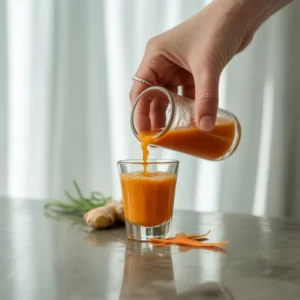
Top Probiotic Drinks to Enhance Your Gut Health
Equipment
- Wide-mouth 1-liter glass jar
- Fermentation weight or clean stone
- Cheesecloth or breathable lid
- Fine mesh strainer
- Clean bottle with cap for storage
Ingredients
Vegetable Base
- 4 medium organic carrots grated
- 2- inch piece of fresh ginger peeled and grated
Fermentation Starter
- 2 tsp sea salt non-iodized, fine grind
- 3 cups filtered non-chlorinated water
Optional Substitutions:
- Swap carrots with beets for a more earthy flavor.
- Add turmeric root for extra anti-inflammatory benefits.
Instructions
- Sanitize: Sterilize a 1-liter wide-mouth glass jar and lid with boiling water.
- Mix: In a clean bowl, combine grated carrots, grated ginger, and sea salt. Massage lightly to draw out moisture.
- Pack: Transfer the mixture into the jar, pressing it down gently. Pour in filtered water to fully submerge the solids.

- Weigh down: Use a fermentation weight or clean glass pebble to keep veggies submerged.
- Cover & Ferment: Cover the jar loosely (or use a cloth + rubber band) and let it ferment at room temp (65–75°F) for 2–3 days.
- Taste: Start tasting after 48 hours. When pleasantly sour and slightly fizzy, it’s ready.
- Strain & Store: Strain into a clean bottle. Refrigerate. Shake gently before each use.
- Serve: Drink 1–2 oz per day, ideally on an empty stomach or 20 mins before meals.
Notes
Nutrition Information (Per Serving)
SERVING: 50ml | CALORIES: 15kcal | CARBOHYDRATES: 3g | PROTEIN: 0.5g | FAT: 0.1g | SATURATED FAT: 0g | CHOLESTEROL: 0mg | SODIUM: 290mg | POTASSIUM: 170mg | FIBER: 0.8g | SUGAR: 1.5g | VITAMIN A: 5400IU | VITAMIN C: 4mg | CALCIUM: 22mg | IRON: 0.3mgEstimated Recipe Cost
Total Cost: $2.80 (7 servings)- Carrots: $1.20
- Ginger: $0.80
- Salt & filtered water: ~$0.80
Recipe Notes
- Substitutions: Replace carrots with beets or daikon for a deeper flavor profile.
- Storage: Refrigerate in a sealed bottle for up to 2 weeks. Flavor intensifies slightly over time.
- Reheating: Not recommended, heat will kill probiotics.
- Variations: Add turmeric or black pepper for an anti-inflammatory twist. A splash of lemon juice post-fermentation adds zing.
Conclusion: Should You Make Probiotic Drinks Part of Your Routine?
Only you can answer that. But let’s zoom out for a second.
You’re here because something nudged you, maybe a feeling in your gut (literally), or maybe just a growing sense that your body’s been sending signals. Probiotic drinks aren’t a silver bullet. They’re not a fix-all. But they can be a quiet, daily step toward feeling a little more in sync with yourself.
For some, it starts with less bloating. For others, it’s about regularity, lighter meals, better moods. And honestly? Even just the act of paying attention to your gut can change how you relate to your health.
So try one. Or try three. Keep what works, ditch what doesn’t. Experiment. Observe. Maybe even make your own, not because it’s trendy, but because it’s empowering.
And if you’re not ready to commit? That’s fine too. Your gut will still be there tomorrow.
Join Our Community!
Follow us on Pinterest, Facebook, and Instagram for more quick weeknight dinners, creamy pasta favorites, and bold chicken recipes that satisfy every craving. From high-protein comfort meals to versatile crowd-pleasers, your next go-to dish is just a scroll away, join our kitchen crew now!
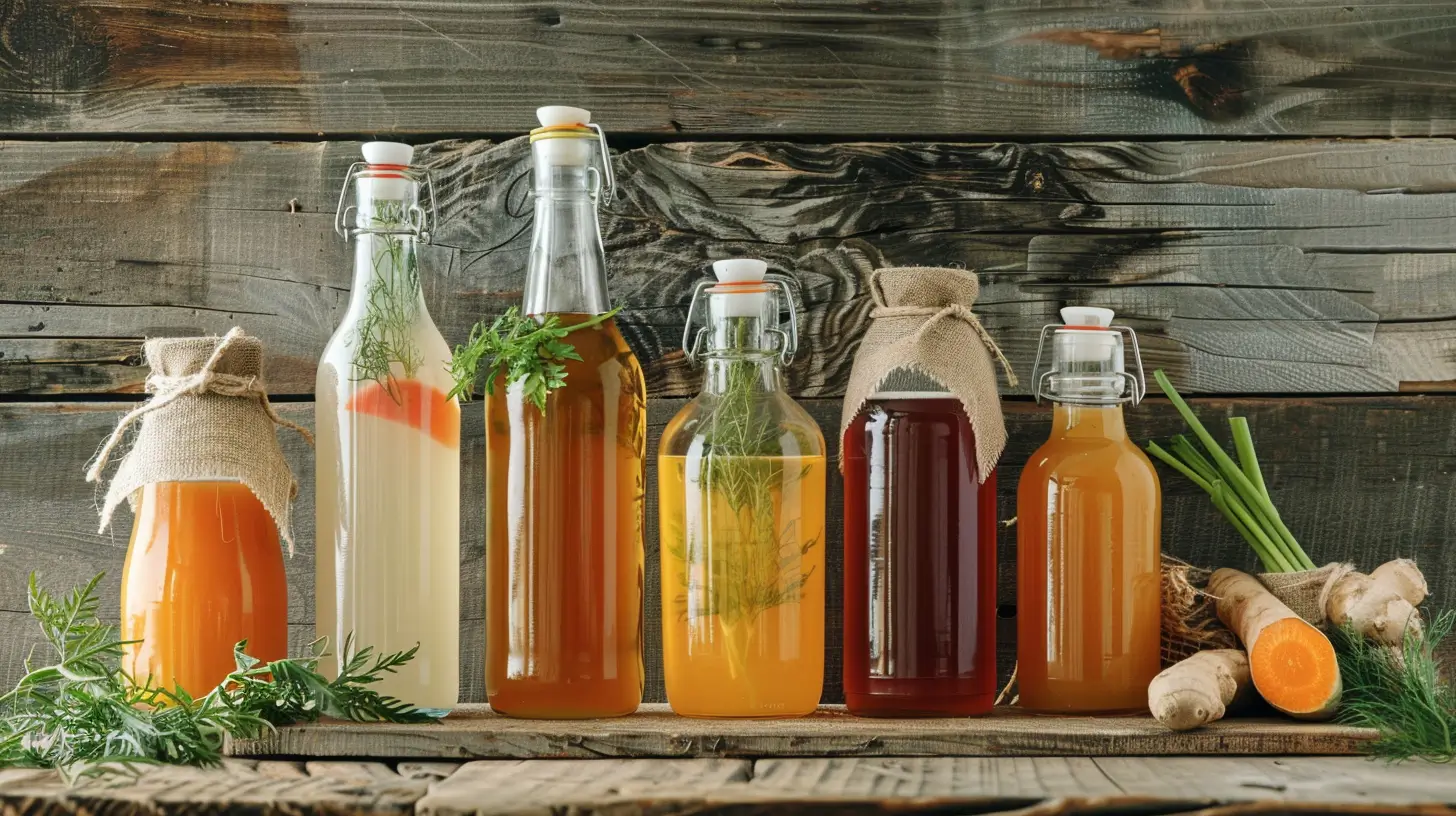
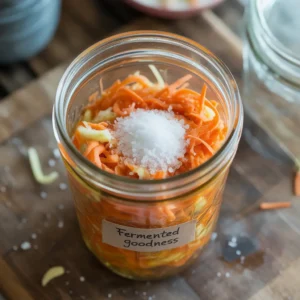
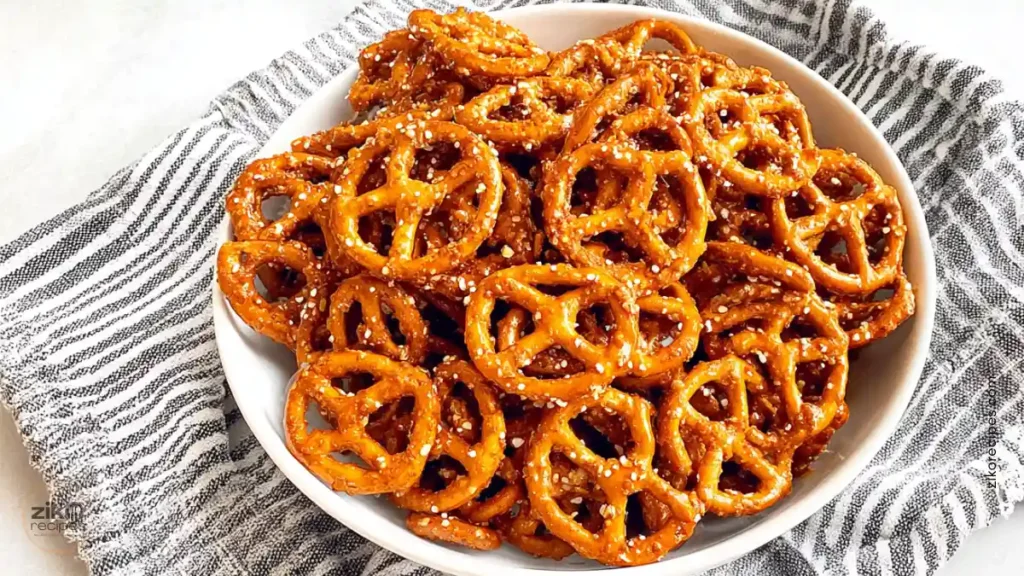
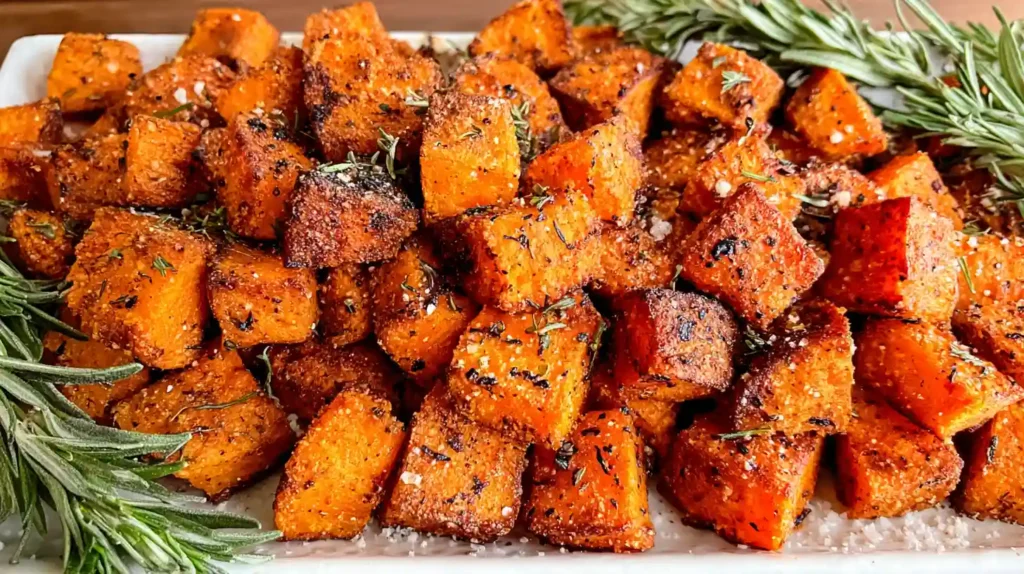


4 thoughts on “10 Best Probiotic Drinks to Enhance Your Gut Health”